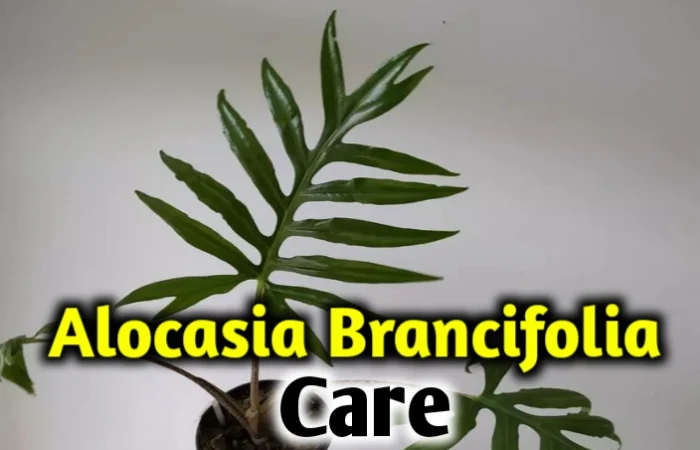9 steps care for Philodendron Grazielae – Get Healthy Grazielae
You may recently own a new Philodendron Grazielae or have an existing one. Philodendron Grazielae care is a pretty easy job. You may have observed some climbing philodendron varieties looking great and increasing the beauty of the indoor. Philodendron Grazielae is one of them. Philodendron is a large genus that has approx 500 species under the Araceae family.
Philodendron Grazielae Care demands indirect bright light with well-draining soil ( Regular Potting mix). They are being good at a temperature of 70 – 84 degrees Fahrenheit with medium moisture. One last thing, good quality fertilizer is needed. Their two popular propagation methods are Stem Cutting, Air Layering method. They have a natural growth habit, so don’t worry.
You may recently own a new Philodendron Grazielae or have an existing one. However, you love your ones and maybe a bit worried about its care.
Don’t worry. You are in the right place. Philodendron Grazielae care is not a big deal. So, to make sure you haven’t made any mistakes or to avoid mistakes in the future you can go through this article. Hope you won’t be disappointed.
It attracts plant lovers with its evergreen, heart-leafed textured foliage. Also, it is the NASA-recommended air-purifying plant. As you know already that it’s a climbing plant, you can use a hanging basket to show off your Grazielae.
Because of doing well under poor lighting conditions and less water requirement, Grazielae becomes one of the wonderful plants in the philodendron family. Now let’s take a look at a general overview of Philodendron Grazielae Care.
Philodendron Grazielae Care Overview
| Category | Property |
| Common Name | Philodendron Grazielae |
| Scientific Name | Philodendron grazielae |
| Family | Araceae |
| Genus | Philodendron |
| Native to | Peru |
| Width | 4-6 inch (approx) |
| Height | 18-24 inch (approx) |
| Foliage | Evergreen, Textured |
| Light | Indirect Bright Light, Low Light |
| Water | Regular avg. water, Don’t Overwater |
| Soil | Regular Potting Mix |
| Temperature | (70-84) F (21-30) C |
| Humidity | Medium moisture |
| Fertilizer | Less than regular |
| Propagation Methods | From Stem cuttings By air layering |
Genus Origin
Philodendron is a huge genus. In the Araceae family philodendron is the second largest member.
Greek word ‘Philo’ means love or endearment. You can identify a Philodendron genus by seeing aerial roots as well as large leaves. And their extraordinary thing is, they can grow anywhere, any situation.
They were identified at a very early age. The plant was first found when it was the 17th century.. In 1829, Heinrich Wilhelm Schott gave their official name.
Philodendron originated from the rainforest of South America. I hear that most of them are also from the West Indies.
Because of coming from tropical areas, they love shady areas. That’s why they are perfect for indoor plants.
Leaves
Philodendron Grazielae has uniquely shaped leaves. You will be amazed to see their heart shaped foliage with extremely glossy green.
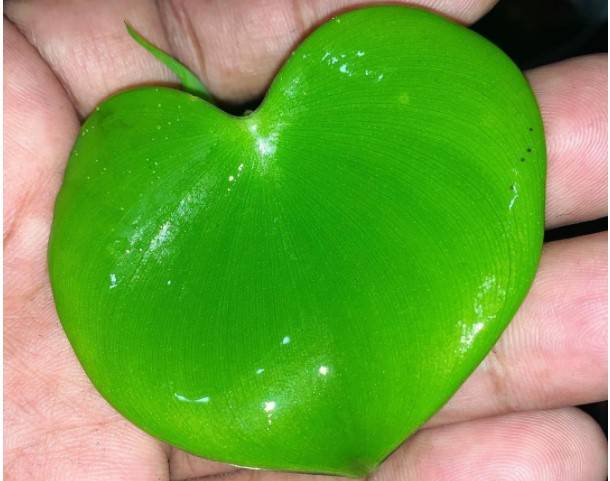
Just see the photo. You will definitely be amazed. As they are climbing plants so I think the larger vase is not necessary. In a normal-shaped pot, they will be ok.
Philodendron Grazielae Care ( Step by Step Guide)
We have known some basic things about our lovely Philodendron Grazielae. It’s time to discuss the complete care guide. We will discuss all step by step.
So let’s dive into our topic Philodendron Grazielae care.
What kind of light do Philodendron Grazielae need?
Let’s start with the lighting condition required for Philodendron Grazielae.
Actually they can tolerate any kind of light, but they prefer indirect bright light. So you have to find a place near the window where the plant isn’t going to receive any direct sun rays.
A good way to give them indirect bright light is to add a white curtain in the window and put them there.
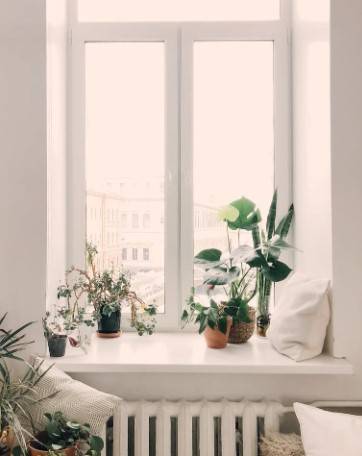
If they get too much direct sunlight you may find that some of their leaves turn yellow or lighten in color. The leaves burn because of too much direct sun exposure.
Though leaves lighten color in leaves is normal in old leaves. But if you see multiple leaves are getting yellow then change the position of the plant.
Again, lack of light is also a problem. If they are not getting enough sunlight they will begin to grow in leggy, the new growth will be slower or it’ll be smaller than what’s normal for the new growth on your plant.
If you want to avoid those kinds of problems and want a healthy philodendron, carefully place your plant in some spot where they get indirect bright light.
I have heard issues about philodendron not growing well. And they had also said that after transferring their plants into brighter indirect light, they had got a very good result.
One more additional tip, you can manage the light of them by providing artificial grow light. It is also a good suggestion for those where the sunlight is not so available.
So I think you have got a clear concept about the proper lighting condition for your philodendron.
You can also take a look at Philodendron Paraiso Verde Care.
Philodendron Grazielae Watering (Best Practice)
Now let’s talk about watering. Philodendron Grazielae is a water sensitive plant.
So, we have to know what types of watering they prefer. Well, they prefer medium watering. Overwatering and underwatering both are harmful to them.
So, to avoid the very common root rot problem, you have to water them perfectly.
Effect of Overwatering and Underwatering
Here’s some indication of overwatering and underwatering-
- Leaves drooping (for both)
- Yellow leaves( for overwatering)
- Brown leaves( for under-watering)
- Stunted growth
How much water do they need?
Ok now the question is how much water do they need? It depends on several factors. I will discuss all below.
- The pot size, If you are using a big pot then they need much water and in small its vice versa. Carefully using a pot which has a hole for drainage.
- In the growing season you should keep soil lightly moist. In the winter season, you should allow the surface of your philodendron to dry between watering.
- Temperature, When they are in high temperature or situated in some place where temperature is high then they need much water. And if they are situated in low temperature or low light then they don’t need much water.
When they need water?
Answer of this question is not so easy. But generally the plant will prefer to be watered once the first 2 to 3 inches of soil is dry. So just stick your finger in there and if it’s dry all the way down, then that may mean that it needs some water.
Another way to identify when to water them is to notice their condition.
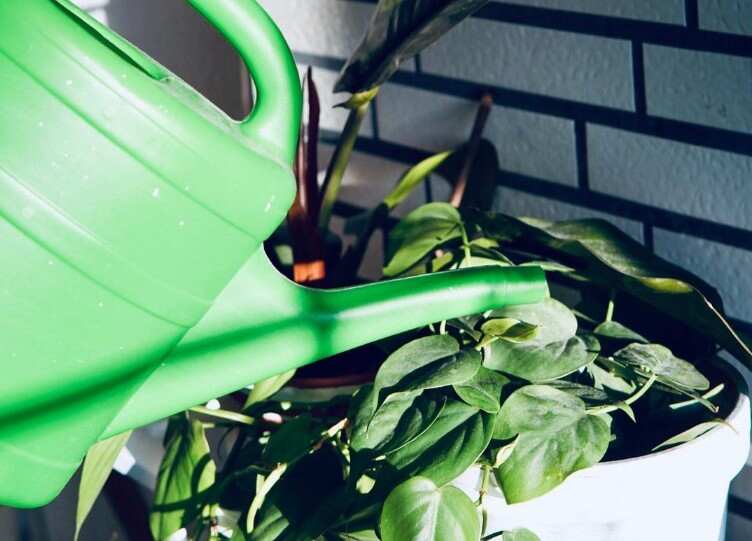
If you notice that the edges of your grazielae plant’s leaves are starting to curl a little bit or drooping then go ahead and check the soil.
If the soil is moist it means they are overwatered. If you see the soil is dry then they are underwatered. So you have to water them.
Which types of water?
It’s not a big deal. But some of you may be confused.
They love rain water actually like other plants because this water is lukewarm. You can use distilled water also.
If you can’t afford it then use tap water but make sure that the water is at room temperature. Cold water gives them shock. You can also use acquirime water.
That’s all about watering. Hope your confusion about watering your Philo Grazielae is over now.
Do you know some Plants can Grow without Soil?
What is the Soil Requirement for Philodendron Grazielae?
In terms of soil Philodendron Grazielae loves ordinary soil like other plants. They love lightweight, nutritious, permeable, well drained soil that is enriched with high organic matter.
You can use garden soil. But, a little suggestion I want to give you, that garden soil retains water, which is not good for your Philo Grazielae.
So use a well drained soil, because the plant has a root rot problem.
You will be amazed to know that philodendron can grow in sphagnum peat moss.
You can also use some mixtures with the soil I have mentioned below-
- Peat moss( it doesn’t dry out the soil quickly)
- Perlite
- Charcoal or coconut fiber( remove toxicity)
- Orchid bark
You can check the soil mix I recommend, here.

Soil is not so important. Just make sure that the soil is well drained. Because if the soil is not well draining the roots of your philo grazielae get wet which causes root rot problem. Again sometimes because of the high density of the mixture water doesn’t drain well. So be careful about this.
Remember Philodendron Grazielae doesn’t like clay type soil. And They love the acidic soil normally. Keep the pH between 5.5 and 6.0.
Which Temperature is Perfect for Philodendron Grazielae?
As usual other tropical plant philodendron Grazielae loves above 70 degree Farenhite. Actually 70F(21C) to 84F(30C) is better for them.
In a low-temperature area, their growth is stunted. You may not see new leaves in low temperatures. A warmer temperature is better for them.
So, in terms of setting up your plant, don’t put them under air condition. And also in winter, this is sensitive.
Don’t put your Grazielae on the door side or window site. In winter remove them from there. The cold temperature will be harmful to your lovely grazielae.
Try to keep the temperature in averring range.
Does Philodendron Grazielae like Humidity?
Now humidity. As Philo Grazielae is a tropical plant, they love higher humidity. But they can easily survive in lower humidity, because Grazielae is a low maintenance plant.
But lower humidity level makes their leaves brown and thinner. Again higher humidity level will make their leaves larger and shiny.
This situation misting is a good solution. Also in the room humidity is low. So misting is more necessary.
In the winter season when the humidity level is getting low which is risky. So you have to increase the humidity level. Humidifiers can be a good solution. Humidity level 47% – 50% is working well.
Another natural solutions are–
- Group your plants for higher humidity because it releases moisture through leaves.
- Using a tray with pebbles and keeping your plant there may increase humidity.
- You can use a misting bottle to spray your plant.
- You can put your plant in the bathroom for a few days.
I hope now humidity is not a big issue for you. In winter, mist them regularly.
What type of Fertilizer does Philodendron Grazielae like?
Next we want to talk about fertilizer. You will be amazed to know that they can survive so well with a little fertilizer. They don’t need heavy fertilizer.
So How can you understand that they need fertilizer? There are some indications. They are-
- The growth is stunted.
- The leaf size is not usual.
- Faded new leaves.
When you find any of these indications, you can make sure that they need fertilizer. If you are regular in fertilizer, you will not observe this type of indication.
In the growing season (like winter & summer) they need fertilizer every month. But in winter and fall they don’t need as much fertilizer as the growing season.
Remember, don’t use over fertilizer. It causes root burn that will kill your lovely plant.
I want to suggest some names of fertilizers you can use with your philo grazielae.
JR Peter Jack’s classic 20.20.2 is one of the best fertilizers for your Philodendron. Try to apply it with water.
If this isn’t available Earth Pod’s premium is a capsule that is used for philodendron. This is easy to use. You should use 1 capsule for small plants, 3-4 for medium and 6-7 for large plants.
Miracle-Gro fertilizer is also good for philodendron. When you use it make sure that you dilute it to half strength.
You can also use your own made fertilizer. You can make it with coffee grounds, eggshells and banana peels. But be careful about the pH of the soil.
How to Propagate Philodendron Grazielae?
Let’s talk about Philo Grazielae propagation. I think this is the topic for which you are eagerly waiting.
Ok. There’s two methods to propagate for your Philo Grazielae. Actually these two methods are used to propagate any type of philodendron. The methods are-
- Stem cutting
- Air layering method.
Now we will know details about both methods.
Stem Cutting
You may think that stem cutting is a difficult job. But you will be amazed that it will be the easiest job for you as a philodendron plant owner after seeing the step by step process of mine. So let’s start.
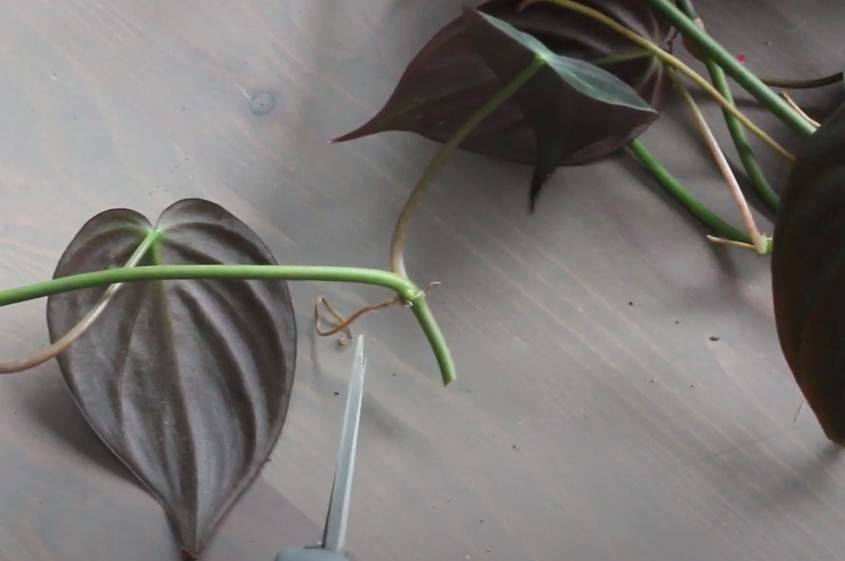
Where to cut the stem?
So this is the primary question of stem cutting. Have you heard about nodes?
STEP- 1: Find the node:
First you have to find the node on the vine. That is where the new growth points are going to come from. This node identification is essential to propagation.
If you look at this vine you can see where the leaf is sprouting out and you’ll also notice a slight ring that goes around the entire vine. That’s going to be your node. Congrats you find it at last.
STEP- 2: Cutting around the node:
So now you have to take cutting around the nodes. Usually, you can leave one to two inches on either side of the node intact.
One thing I want to mention is that you will need sterilized pruning shears. You can sterilize your pruning shears with 70% isopropyl alcohol. So, congrats. Now you are ready for this stem-cutting propagation of your Philo grazielae.
STEP- 3: Wait for Callous Over:
After you have done your stem cutting, it’s time to cure it. First, you need to keep it in a warm room. Keep it at least one week. This will be callous over the stem cutting. Having the end callous over is beneficial. The biggest benefit is, callous over helps the stem cutting for becoming a root.
STEP- 4: Making your Pot Ready:
At that time when the stem is becoming callous over you will need to make your plant pot ready. You can also use a hanging basket. In terms of soil, make sure you are using well-draining soil. Also use the plant pot with drainage holes.
STEP- 5: Plant Your Cutting:
Ok. It’s time to plant your stem cutting in the pot. It’s not a hard job. Just make a hole with your finger. Place your full finger into the potting soil. Remove the finger and then set your grazielae cutting into that hole and pack soil around your grazielae. Try to pack soil around your plant so that it can keep your cutting upright. If not possible tie a straw to keep it straight up.
You are done. Now your only job is to wait for your stem cutting to convert into an amazing new philodendron grazielae.Care for it according to the above description.
Air Layering Method
Air layering method is another common technique of philodendron grazielae propagation. In this method you have to wound your original plant. This wound needs to create towards the top of the plant. That’s why it will be easy to remove from the original plant later.
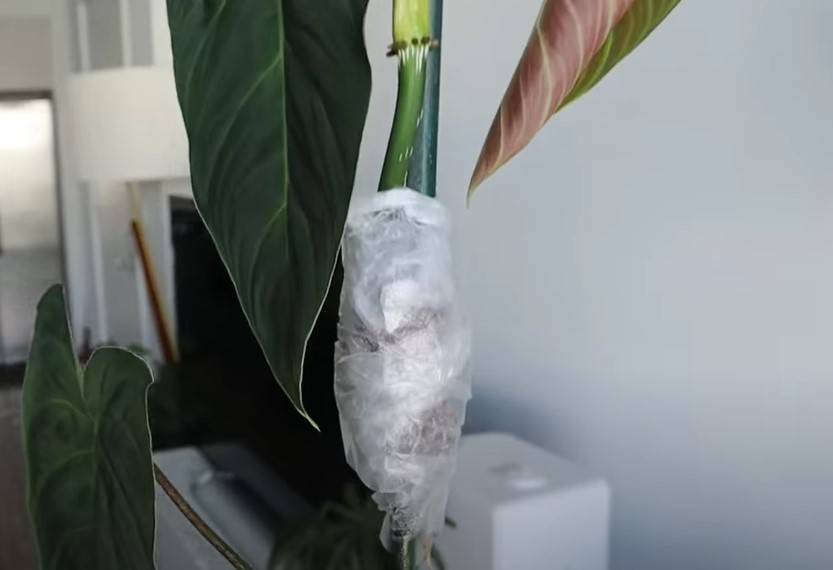
STEP- 1: Create the Wound:
First, create a wound with a sterilized knife. (The sterilization process is mentioned above step 2 of stem cutting.) The size of the wound needs to be 2 inch X 2-inch width and depth both. Here’s sometimes a little problem happens. Some plant wounds can’t stay open alone. You can solve the issue by sticking a toothpick right with it.
STEP- 2: Sphagnum Peat-moss Adding:
First, you have to check the sphagnum peat-moss to become moist. Because without moist it can’t stick with the wound. Now take some sphagnum peat-moss in hand and smear it across the wound.
STEP- 3: Plastic wrap to the wound:
Now wrap the wound with a plastic. Don’t wrap too tightly. Also use a tape to hold the plastic with the stem.
STEP- 4: Making your Pot Ready:
You can also use a hanging basket. In terms of soil, make sure you are using well-draining soil. Also use the plant pot with drainage holes.
STEP- 5: Collect the wounded stem with Root:
It takes a few weeks to come out roots from the sphagnum peat-moss. When the roots are around three or four inches in length you can remove the wound from the stem. Remember to use a sterilized knife to remove the wound. Now remove the plastic from the wound. Be careful because you don’t want to do any harm to your newborn roots.
STEP- 6: Plant your Grazielae into the new pot:
Now plant your lovely grazielae into your ready new pot.
Now take care as you do the original new plant according to the above instruction.
Where to Buy Philodendron Grazielae?
Philodendron Grazielae is pretty demandable plant. Because of their heart shaped, pretty looking leaves, they attract too much to plant lovers.
You can collect them from other grazielae owners with the above-mentioned propagation methods. Also, it is available in some local nurseries near you.
Etsy is also a good option to collect philo grazielae. I think if you are a plant lover collecting a grazielae is not a big deal for you.
How to Repot Philodendron Grazielae?
Philodendron Grazielae repotting is not a big deal. You can repot them after a year or two. They grow a little bit slow.
My suggestion is to use pots with drainage holes so that when roots poke through you can understand that it’s time to repot your philo grazielae. Also when they look so big there’s a problem of root bound. So repot them then.
You can use good soil mixtures for repotting.

Just softly pick the plant from their old home and replace it in the new home.
Common Pests Attack of Philodendron Grazielae
You may face some pests while caring for your philo grazielae. It’s very common. Only a few plant pests are attracted by this plant. Let’s discuss-
Aphids
The first name when talking about common philodendron pests comes is aphids. They hide under the leaves of your plant.
What they do is, they suck the sap from the plant leaves. And creates sooty mold (according to University of Kentucky). This sooty mold attracts the other pests like ants. And ants do the ultimate destruction.
Brown Scales
Here’s the brown scales, the most common scale pests of philodendron grazielae. In these days of climate change they have become the bigger plant problem.
They suck up all the important nutrients and water. Those nutrients and water in the sap are moved throughout the whole plant by some special cells. This affects the photosynthesis of the plants.
Mealybug
The fastest reproductive plant pest is mealybug. It also harms your plant by stealing it’s sap from the plant.
But the problem is it’s fast reproduction. Before you learn that there’s a problem, you might have a huge infestation on your hands.
Treatment for Plant Pests
Here we don’t have a huge discussion about pests treatment.
One of the common natural discussions is neem oil. Mix neem oil with water into a spray bottle and spray down your philo grazielae.
Neem oil suffocates the pests within minutes of applying time.
Finally, just wipe your grazielae down for dead pests.
FAQs
Does the Philodendron Grazielae Plant Have Vines?
Yes, this plant has vines. Grazielae is a good climber.
Why are my Philo Grazielae Leaves Getting Yellow?
It normally happens for over-watering. When the plants felt a lack of oxygen getting to its root.
If leaves yellowing happens you should always check the moisture of the soil before watering your grazielae.
Natural way to check the humidity is to stick your finger into the soil up to the knuckle. If the soil is dry to the tip of your finger, it will need watering.
Hope this will solve your problem.
Is Philodendron Grazielae Toxic for Cats?
You may already know that the Philodendron genus is toxic.
Philo Grazielae is toxic as well. Both leaves and stems are wrapped with calcium oxalate crystals.
These crystals are harmful to both humans and pets.
If you want to know details about toxicity you can take a look at this.
Are Philodendron Toxic to your Pets?
Products You can consider as per our recommendations-
| Products | Recommendations | Price |
| Plant Pot | Amazing Looking White Pot | Check Price |
| Soil | Black Gold All Organic Potting Soil | Check Price |
| Fertilizer | Espoma Organic Grow Fertilizer | Check Price |
| Pest Control | Neem Bliss-Neem Seed Oil | Check Price |
| Humidity | LEVOIT Smart WiFi Humidifier | Check Price |
| Misting | Transparent Spray Bottle | Check Price |
| Tools | Small Propagating Toolset | Check Price |
Final Thoughts
Hope your demand is fulfilled by reading this article about philodendron grazielae. This is a nice plant that doesn’t need so much care. It,s beautiful heart-shaped foliage attracts many plant lovers.
It’s your turn. Did I miss anything?
Let me know in the comment section. Or appreciate me so that I get inspired to more valuable content.


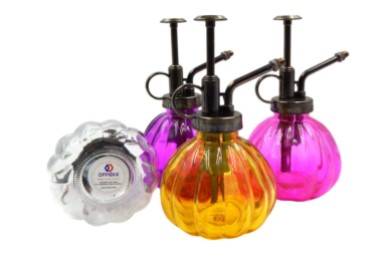
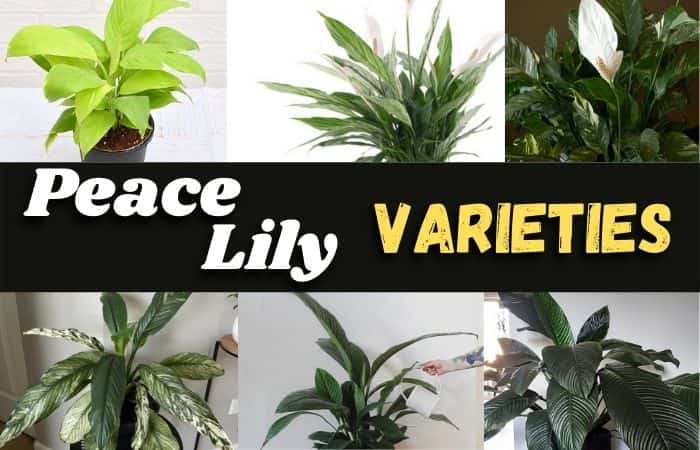

![Snake plant watering schedule – [Quantity, Time, Interval]](https://diaryforgardening.com/wp-content/uploads/2022/02/Snake-Plant-Watering.jpg)

![Alocasia Nebula care, propagation, leaves problems [All you need to know]](https://diaryforgardening.com/wp-content/uploads/2022/09/Alocasia-Nebula-Care.webp)
